Maroc avril 2004
Morocco 9th-18th April, 2004
A birding trip report
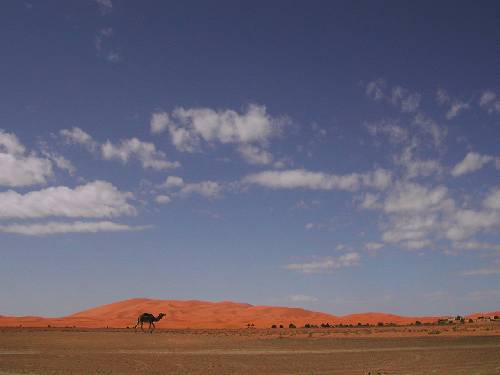
Lutz Lücker – Petit-Lancy/Geneva
Daniel Nussbaumer – Neuchâtel
Journey and weather
Since we had less than 10 days for a
We arrived in Casablanca airport and hired an air-conditioned Toyota Corolla from Hertz. Tyres a bit worn but no punctures on
Route: roughly Casablanca-Agadir- Oued Massa -Taroudannt-Ouarzazate-Zagora (and back)-Boulmalne Dades -Tinerhir- Gorges du Todra -Touroug-Jorf-Rissani-Merzouga- Erg Chebbi Dunes -Erfoud- Er Rachidia -Rich-Midelt-Zeida- Col de Zad -Azrou-Ifrane-Mischliffen-Meknes-Rabat- Sidi Yahya Zaër -Casablanca.
Target species
Having never been to Morocco, our main goal was to see a wide variety of habitats and to take anything as a bonus. Due to the windy weather conditions we missed a few, mostly small birds like Fulvous Babbler (Cratérope fauve), Mourning Wheatear (Traquet deuil), Desert and Tristram's Warbler (Fauvette du désert + de l'Atlas), and dipped on others because we did not arrive at their stakeout at the right time of day (Pharaoh Eagle Owl (Grand-duc du Sahara), Double-spurred Francolin….). Well, one needs some reasons to come back….
What we did find were all the 14 lark (alouettes) species (including Dupont's, which we found within 10 minutes in broad daylight,) and 100+ Bald Ibis (Ibis chauve). So let's not complain! The only gen we could rely on were other trip reports we found on the internet. Alas, this has become all too easy which means more and more disturbance (for the Ibises and others…)! actually we did not see any uncommon birds for Morocco so this report is just a small supplement to all the others.

8th April
Missed the Oualidia road and found ourselves on the way to Settat. Went on to Khemis-Zemamra via Sidi-Bennour . Saw a few Collared Pratincoles (Glaréole à collier) there. Arrived at TAMRI , 60 kms north of Agadir shortly before sunset. First Bulbuls, African race Chaffinch (Pinson des arbres) and Pallid Swifts (Martinet pâle). And sure enough, soon there was a Bald Ibis (Ibis chauve) flying across the fields and sand dunes. So we decided to stay put and did not regret it. More and more ibises came along, flying close by, one landing and feeding barely
As it was getting dark we concentrated on the sand cliff where about 60 ibis pairs were rearing their (quite big) chicks, together with maroccanus Cormorants (Grand Cormoran),
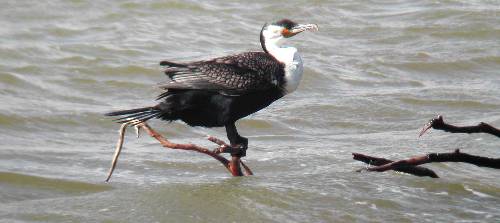
Rock, Doves AND –surprise!- a Barbary Falcon (Faucon de Barbarie) on its 3 eggs! Finally, night falling, the reserve warden, who had been sitting just a few yards above the colony with the 3 other birders, told us to leave, what we did, being at least sure that we were the only people who had not deliberately disturbed the birds. Funny business!
Night in Hotel Tivoli in Agadir with garden Bulbuls (Bulbul des jardins). Very nice but not very cheap.
9th April:
Early morning start to Oued Massa Reserve. Coffee at the hotel in Sidi Rbat, overlooking the beach with plenty of Audouin's Gulls (Goéland d'Audouin) and a few Kentish plovers (Gravelot à collier interrompu). The first House Buntings (Bruant striolé) and at least 4 Moussier's Redstarts (Rougequeue de Moussier) in the area.
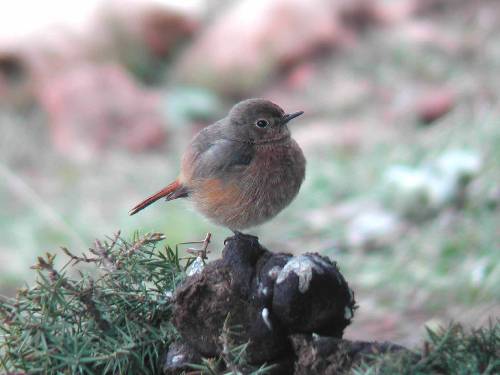
A few Gannets (Fou de Bassan) off shore. No rare Terns (sternes) along the shore so we made for the track along the river where a kind warden received us to show us a sunbathing Little Owl (Chevêche d'Athéna). Some way upstream, 29 Glossy Ibises (Ibis falcinelle), 1 Flamingo, 1 Spoonbill (Spatule blanche), 3 Marbled Duck (Sarcelle marbrée). A pleasant, whistling song from the bushes reminded us that this was THE place for Black-crowned Tchagra (Tchagra à tête noire). And there he was, sitting atop a bush in the strong breeze. Smashing bird! We were to hear 3 or 4 more, but invisible ones. We had the first of many Red-rumped Swallows (Hirondelle rousseline), a Montagu's Harrier (Busard cendré), 2 Night Herons (Bihoreau gris), a few algeriensis Western Grey Shrikes (Pie-grièche grise), then we flushed 2 Barbary Partridges (Perdrix gambra) (poor views only…), and saw a lovely mauretanicus Magpie (Pie bavarde). 1 Squacco Heron (Crabier chevelu) near Massa village bridge. Went down to Taroudannt but saw nothing special due to the stormy winds. Night in Agadir with Audouin's Gulls (Goéland d'Audouin) seen from our balcony!
10th April:
Decided to make headway to Ouarzazate. Found a very dead Red-necked Nightjar (Engoulevent à collier roux) on the road to Oued-Issène where we spotted a splendid Lanner Falcon (Faucon lanier) pounding on some hapless bird. In Taroudannt, first Little Swifts (Martinet des maisons), Pallid Swifts (Martinet pâle), more Red-rumped Swallows (Hirondelle rousseline), White Storks (Cigogne blanche), House Buntings (Bruant striolé). At the foothills

1 Long-legged Buzzard (Buse féroce) and the first Black Wheatear (Traquet rieur). But no Dark chanting Goshawks (Autour sombre) or Tawny Eagles (Aigle ravisseur)! Near Oulad-Berrehil, we counted migrating 500 Black Kites (Milan noir) in 20 minutes, and some time later, the whole Souss valley was crowded with those big birds struggling against the strong Atlantic winds. There must have been a "flock" of more than 1000, an unforgettable sight!
From the Aoulouz bridge we spotted …. 1 Spotted Crake (Marouette ponctuée), Crag Martins (Hirondelle de rochers), Red-rumped Swallows (Hirondelle rousseline), 1 Squacco Heron (Crabier chevelu), 3 Booted Eagles (Aigle botté). At Taliouine 1 Short-toed Eagle (Circaète Jean-le-Blanc). West of Tazenakht first Red-rumped Wheatears (Traquet à tête grise) (1 Black), north of the town the first singing Desert Larks (Ammomane isabelline). At dusk, in the oued
Night at (good but nightjarless) Hotel Le Zat.
11th April:
On the El Mansour dam road a family of 4 Black Wheatears (Traquet rieur) + more Desert Larks (Ammomane isabelline). In a wadi and a village before Tizi-n-Tinififft pass (1660m) Tawny Pipits (Pipit rousseline), Bonelli's Warbler (Pouillot de Bonelli)

and the first of many White-crowned black Wheatears (Traquet à tête blanche). Just outside Agdz 1 Barbary Falcon (Faucon de Barbarie), further SE 2 Blue-cheeked Bee-eaters (Guêpier de Perse) chasing insects in the river bed,
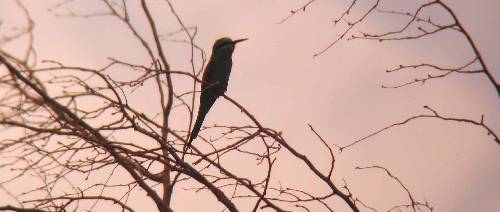
a lovely subpersonata White Wagtail (Bergeronnette grise), a singing contest of 3-4 Olivaceous Warblers (Hypolaïs pâle), 1 Cetti's Warbler (Bouscarle de Cetti), and 30+ Rock Doves (Pigeon biset) along the cliffs.
We drive through Zagora until the sand dunes of Tinfou where we choose the Porte du Sahara Hotel in the middle of the desert. Not expensive, off the main road, no need of a car to go birding. The German owner, having just bought an astronomic telescope, readily switches off the lights in late evening so that we can watch millions of stars. The sky is just unbelievable…
We hear a Stone Curlew (Oedicnème criard),
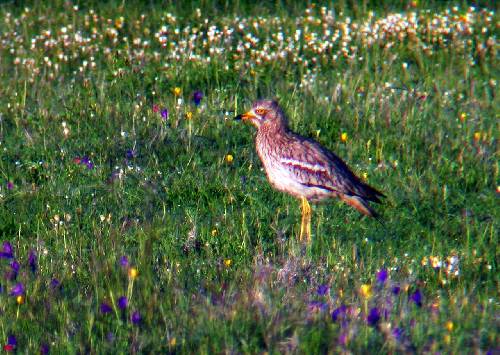
see 2 Desert Larks (Ammomane isabelline), a possible Brown Raven (Corbeau brun) at the river
12th April:
Early morning start. We quickly find 3 Cream-coloured Coursers (Courvite isabelle) (1 with a fledged chick),
13th April:
Early morning start. We had to tell the staff at Hotel Soleil Bleu that we needed the doors (and gate) to be opened at 5.20h, otherwise we'd have been stuck inside!
Along the Tagdilt track (and the tarmaced road to Ikniounn) we hear several Temminck's horned Larks (Alouette bilophe) and Hoopoe Larks (Sirli du désert), a pair of which start mating while we watch…. A flock of 7 Crowned Sandgrouse (Ganga couronné) fly just over our heads, the only sandgrouse of the trip!
Suddenly, a bird on a rock turns out to be a stunning male Thick-billed Lark (Alouette Clot-Bey)which even performs a few whistles of its extremely inconspicuous song. A Long-legged Buzzard (Buse féroce) is mobbed by two NorthernWheatears and there are more Desert Wheatears (Traquet du désert) and Red-Rumped Wheatears (Traquet à tête grise). After breakfast we return to a parallel track that ends in a large pool of water from some irrigated fields. But we find an empty Hoopoe Lark (Sirli du désert)'s nest and spot 4-5 Montagu's Harriers (Busard cendré) one of which is a suberb male of the melanistic form.
Afternoon in the Gorges du Todra. Only a few Rock Doves (Pigeon biset), several Blue Rock Thrushes (Monticole bleu) and commoner species. The first Nightingales (Rossignol philomèle) in the exquisite palm groves of Tinerhir.
On our way to Rissani we pick up Nourdine El Jakani, a young Berber camel driver, who leads us to the Auberge Lahmada, a few yards from the famous Erg Chebbi dunes near Merzouga. He knows all the tracks by heart and we arrive at sunset without getting stuck in quicksand or breaking an axle. Nourdine knows the area like the back of his hand and can be contacted under eljakaninourdine@yahoo.com !
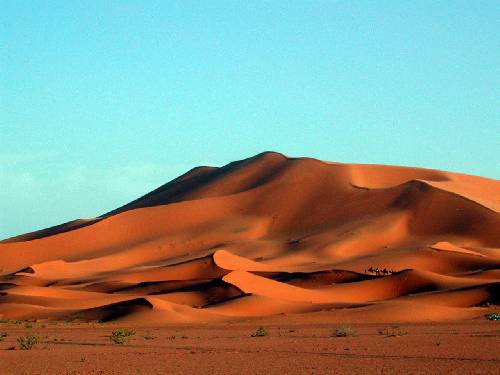
14th April:
After an unproductive but beautiful sunrise (just a few migrants like Subalpine Warblers (Fauvette passerinette), Bonelli's Warblers (Pouillot de Bonelli), Nightingales (Rossignol philomèle), speculigera Pied Flycatcher (Gobemouche noir), Olivaceous Warbler (Hypolaïs pâle) and Wood Warbler (Pouillot siffleur) in the shrubs and gardens behind the famous neighbouring Café Yasmina and our hostel we have breakfast with 2 Desert Sparrows (Moineau blanc) that seem to be after our breadcrumbs.
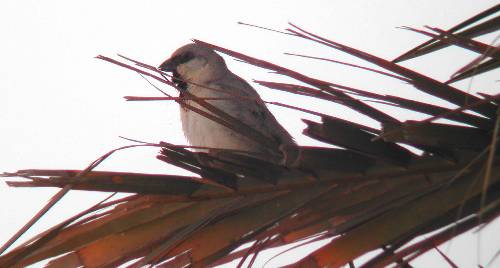
Then we decide to take Nourdine with us to have a look at an Oasis and a lake. In a minute palm grove near the Café Erg Chebbi there are 7-8 more Desert Sparrows (Moineau blanc) as well as a Brown-necked Raven (Corbeau brun). The oasis proves surprisingly unproductive (except for a few Palm Doves (Tourterelle maillée)/Laughing Doves (Tourterelle maillée)) but the Dayet Srij lake near Merzouga (good track from the last (pink) house of the village) holds 86 Flamingoes, 70 Marbled Teal (Sarcelle marbrée), 160 Ruddy Shelduck (Tadorne casarca)

, lots of Black-winged Stilt (Échasse blanche) and there is an elegans Southern Grey Shrike (Pie-grièche méridionale) in the shrubs. But no Desert Warblers (Fauvette naine)! At sunset we are on the dunes again. But the only bird worth mentioning is…. a lone Ruddy Shelduck (Tadorne casarca)!
15th April:
We return to Café Yasmina where we spot 1 female Desert Sparrow (Moineau blanc), a few migrants in the bushes as well as a fabulous Rufous Bush Robin (Agrobate roux) which puts on a great show.
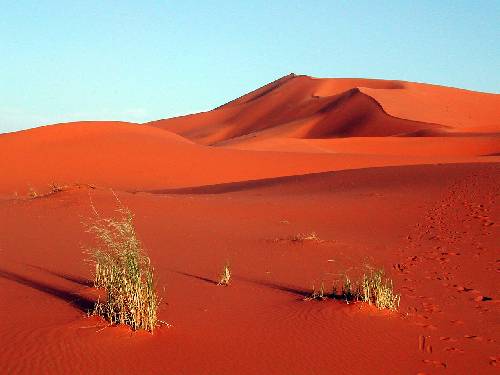
We leave the area just in time,driving just ahead of a middle-sized sandstorm. On our way to Erfoud we see 3 more Brown-necked Raven (Corbeau brun) near the track between Auberge Lahmada and Café Erg Chebbi. Near the end of Rissani village 2 Blue-cheeked Bee-eaters (Guêpier de Perse) careen after insects in the palm grove; we see another one north of Erfoud. The blue source of Meski costs us a 5 Dirham parking fee for a few Olivaceous warblers (Hypolaïs pâle), Cetti's Warbler (Bouscarle de Cetti) and a second subpersonata White Wagtail (Bergeronnette grise). Around Er Rachidia, lots of European Bee-Eaters (Guêpier d'Europe) on migration, two very flat ones on the road. In the Gorges du Ziz we see a Peregrine (Faucon pèlerin) type falcon (that might have been a Barbary, but no Tristram's warblers (Fauvette de l'Atlas)…Too windy!)
After Tizi-n-Talrhemt pass it gets bitterly cold. We arrive in the steppe
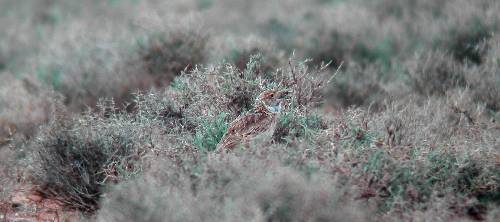
We get a cheap but very modest room at the only "hotel" in Zeida (no hot water, tiny washbasin, shower drain clogged…) and a warm evening meal in one of the village's inns. Rain during the night.
16th April:
After breakfast we check on the Dupont's Larks (Sirli de Dupont) at 9, and sure enough, there are still 3 singing males around with "our" bird performing exactly where we left our orange peels on the previous evening. They seem to be common birds in this area which also holds Lesser short-toed Larks (Alouette pispolette) and Red-rumped Wheatear (Traquet à tête grise).
On we go and up into the Middle Atlas. Nothing special at the Aguelmane Sidi Ali but the large high plateau marshes between the lake and the Col de Zad pass abound with white Storks (Cigogne blanche) and Ruddy Shelduck (Tadorne casarca). The area by the small lake
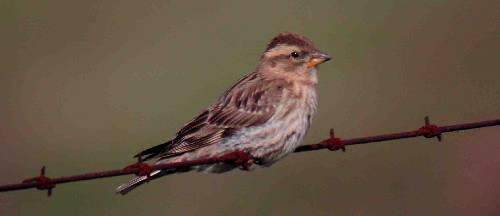
both Blue Rock Thrush (Monticole bleu) and Rock Thrush (Monticole de roche), lots of beautiful seebohm Wheatears (Traquet motteux de l'Atlas),
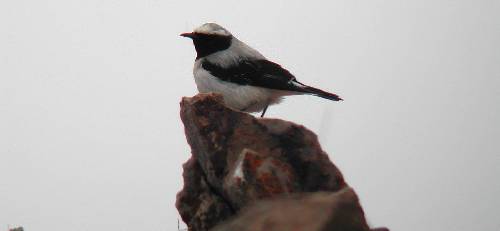
Red-billed Chough (Crave à bec rouge), Peregrine (Faucon pèlerin), Atlas Shore Lark (Alouette haussecol), and a Ruddy Shelduck (Tadorne casarca) family of 11.
We drive back to the pass and spend 2 hours looking for Levaillant's Woodpecker (Pic de Levaillant). A hard piece of work but we do find him on top of a Cedar-covered hilltop half a mile west of the pass.

Several Moussier's Redstarts (Rougequeue de Moussier), stunning ultramarinus Blue Tits (Mésange bleue), Rock Bunting (Bruant fou), and lots of coniferous wood species. But the most magnificent thing are the majestic Cedar giants, dead or alive!
We continue towards Azrou (1 Booted Eagle (Aigle botté)) and find an even more cooperative Levaillant's Woodpecker on the far side of Dayet Aoua lake,

and before we go to our Hotel Le Chamonix in Ifrane, we spot 6 Rollers (Rollier d'Europe) on the wires along the road by the lake!

17th April:
More than

1 more Booted Eagle (Aigle botté), 1 Long-legged Buzzard (Buse féroce), Black Wheatear (Traquet rieur), Seebohm's Wheatear (Traquet motteux), a few waders, our only Spectacled Warbler (Fauvette à lunettes)…and 4 Wood-Pigeons! Some miles further, 1 Short-toed Eagle (Circaète Jean-le-Blanc).
We drive towards the Tizi-n-Tretten pass (
We choose to drive to Rabat as quickly as possible to get to the Double-spurred Francolin (Francolin à double éperon) stakeout south of Sidi Yahya Zaër before dusk. 22 and
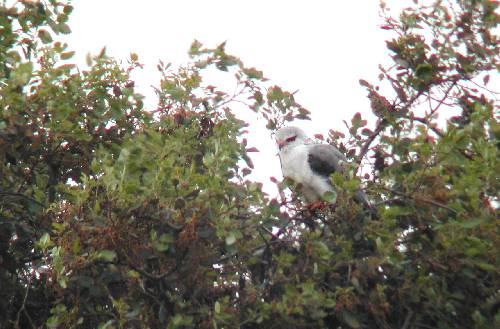
We also saw the 6th Long-legged Buzzard (Buse féroce) of the day, 2 more Booted Eagles (Aigle botté), heard a Golden Oriole (Loriot d'Europe), and flushed 2 Barbary Partrige (Perdrix Gambra), but the Francolins remained invisible…
That was a splendid finale of an unforgettable trip.
Hotel in nightmarish downtown Casablanca, a few Little Swifts (Martinet des maisons) at the airport in the morning, and it's Bye-bye until the next time which – Inch Allah – is sure to come!
Inscrivez-vous au blog
Soyez prévenu par email des prochaines mises à jour
Rejoignez les 19 autres membres